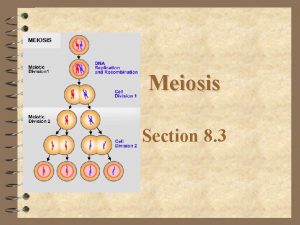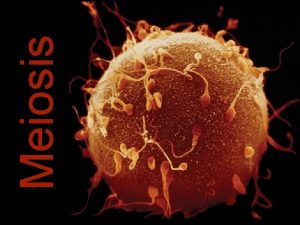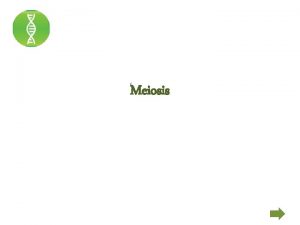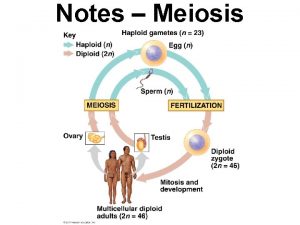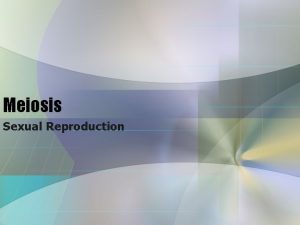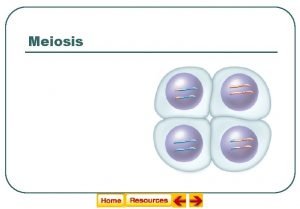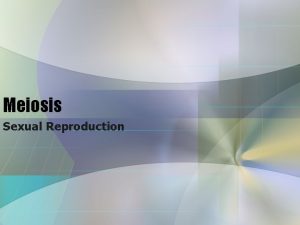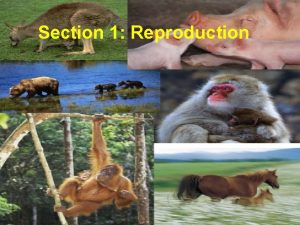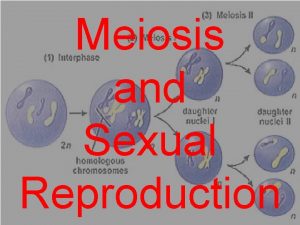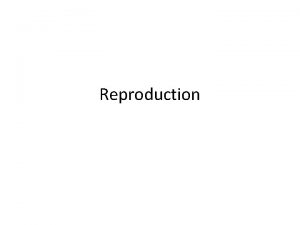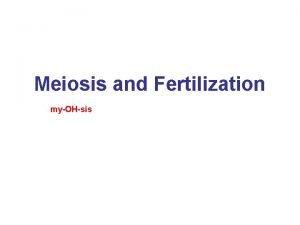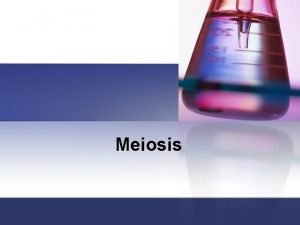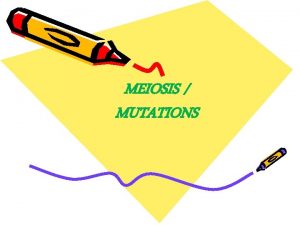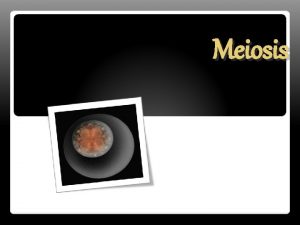Meiosis 1 Reproduction Reproduction is the process of




















- Slides: 20

Meiosis 1

Reproduction • Reproduction is the process of producing offspring • Some offspring are produced by two parents • Some offspring are produced by just one parent • Whether an organism is identical or similar to its parent is determined by the way that the organism reproduces

Asexual Reproduction • When a single “parent” passes a complete copy of its genetic information to each of its offspring • An individual formed by asexual reproduction is genetically identical to its parent

Types of Asexual Reproduction • Binary Fission: Reproduction performed by most prokaryotes

Types of Asexual Reproduction • Fragmentation: A kind of reproduction in which when the body of an organism breaks into several pieces, some or all of these fragments re-grow missing parts and develop into complete adults

Types of Asexual Reproduction • Budding: In budding, new individuals split off from existing ones

Types of Asexual Reproduction • Parthenogenesis: A process in which a female makes an egg that grows into an adult without being fertilized by a male

Sexual Reproduction • Practiced by most eukaryotic organisms • In sexual reproduction, two parents give genetic material to produce offspring that are genetically different from their parents • Each parent produces a gamete (reproductive cell) • Gamete from one parent fuses with gamete from another parent to form a zygote • This process is called fertilization

Germ Cells & Somatic Cells • Germ cells are cells that are specialized for sexual reproduction (sperm & egg) • Somatic cells are all other body cells. They DO NOT participate in sexual reproduction

Asexual vs. Sexual Reproduction • Asexual reproduction – Advantages: Very efficient - can reproduce a lot in a short period of time – Disadvantages: Organisms can die off easily if the environment changes

Asexual vs. Sexual Reproduction • Sexual reproduction – Advantages: Produces genetically different organisms so a population could survive in a changing environment – Disadvantages: It could take a lot of energy to find a mate

Chromosome Number • Genes are located on Chromosomes • Each chromosome has thousands of genes that play an important role in determining how an organism develops and functions • Each species has a unique number of chromosomes (mosquitoes = 6; humans = 46; ferns = 500) • If an organism has too many or too few chromosomes, the organism may not develop and function properly

Chromosome Number • When fertilization occurs, two cell combine to form a zygote • The gametes that form a zygote have only ONE copy of each chromosome (not two, like somatic cells) • This ensures that the resulting zygote has the correct number of chromosomes

Haploid vs. Diploid • Cells that are diploid (somatic cells) have two sets of chromosomes (2 n) • Cells that are haploid (gametes) have one set of chromosomes (n)

Homologous Chromosomes • Each diploid cell has pairs of chromosomes made up of two homologous chromosomes • Homologous chromosomes are chromosomes that are similar in size, in shape, and in the kinds of genes they contain • Each chromosome in a homologous pair comes from one of the two parents

Autosomes and Sex Chromosomes • Autosomes are chromosomes that do not determine the sex of an individual • Sex chromosomes have genes that determine the sex of an individual • All humans receive an X chromosome from their mother • If they receive an X chromosome from their father, the human is a girl (XX) • If they receive a Y chromosome from their father, the human is a boy (XY)

Meiosis • During meiosis, a diploid cell goes through two divisions to form four haploid cells

Mitosis vs. Meiosis • Mitosis creates 2 daughter cells that are genetically identical • Meiosis creates 4 daughter cells that are genetically different • Mitosis makes cells that are used during growth and repair – happens in body cells • Meiosis produces cells that allow an organism to reproduce sexually – only happens in reproductive structures


Genetic Variation • Genetic variation is advantageous for a population • It can help a population survive a major environmental change • Genetic variation is made possible by SEXUAL reproduction
 Phases of meiosis
Phases of meiosis Meisis 1 and 2
Meisis 1 and 2 Concept mapping chapter 10 meiosis 1 and meiosis 2
Concept mapping chapter 10 meiosis 1 and meiosis 2 Difference between meiosis 1 and 2
Difference between meiosis 1 and 2 Chapter 10 section 1: meiosis
Chapter 10 section 1: meiosis Chapter 10 meiosis 1 and meiosis 2 answer key
Chapter 10 meiosis 1 and meiosis 2 answer key Prophase of meiosis 2
Prophase of meiosis 2 Sexual reproduction and genetics section 1 meiosis
Sexual reproduction and genetics section 1 meiosis Sexual reproduction and genetics section 1 meiosis
Sexual reproduction and genetics section 1 meiosis Meiosis makes gametes
Meiosis makes gametes The disadvantages of sexual reproduction
The disadvantages of sexual reproduction Asexualk
Asexualk Sexual vs asexual reproduction venn diagram
Sexual vs asexual reproduction venn diagram Cell having 6 chromosomes that undergoes meiosis
Cell having 6 chromosomes that undergoes meiosis Hát kết hợp bộ gõ cơ thể
Hát kết hợp bộ gõ cơ thể Lp html
Lp html Bổ thể
Bổ thể Tỉ lệ cơ thể trẻ em
Tỉ lệ cơ thể trẻ em Gấu đi như thế nào
Gấu đi như thế nào Glasgow thang điểm
Glasgow thang điểm Alleluia hat len nguoi oi
Alleluia hat len nguoi oi









